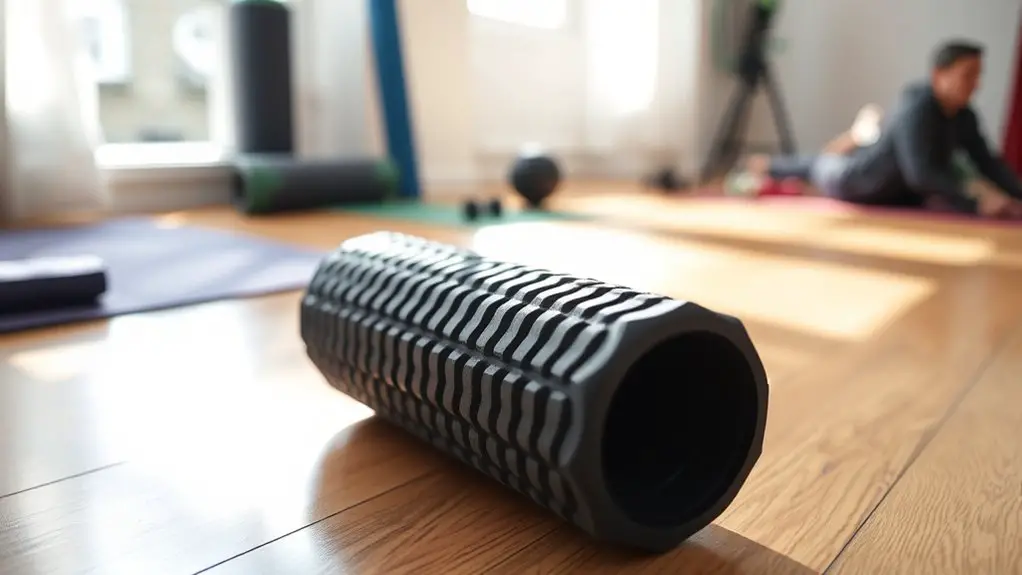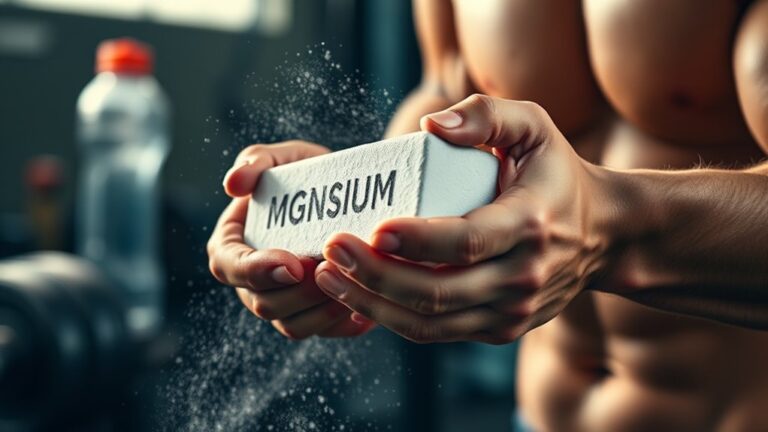The Science of Foam Rolling: Does It Really Work?

Foam rolling is a popular self-myofascial release technique that can help improve your muscle recovery and flexibility. It works by applying pressure to tight muscles, which enhances blood flow and reduces soreness after workouts. While research shows mixed results regarding its effectiveness for muscle recovery, many athletes find it beneficial for increasing blood circulation and easing tightness. If you’re curious about how to maximize its benefits and bust some myths, there’s more to explore.
What Is Foam Rolling?

Foam rolling is a self-myofascial release technique that helps relieve muscle tightness and improve flexibility. By using a foam roller, you can target specific muscle groups to alleviate tension and enhance your range of motion. There are different foam roller types available, including high-density, low-density, and textured rollers, each offering unique benefits depending on your needs and comfort level.
When you start foam rolling, it’s essential to use proper foam rolling techniques. Begin slowly, applying gentle pressure to the targeted area and gradually increasing intensity as your muscles adapt. Focus on areas that feel tight, rolling for about 30 seconds to a minute. Remember to breathe deeply and relax your muscles during the process. Always listen to your body, and if you experience pain, ease off or consult a healthcare professional. This way, you can safely and effectively incorporate foam rolling into your routine.
The Mechanism Behind Foam Rolling
Understanding how foam rolling works can enhance its benefits. At its core, foam rolling employs pressure application to target tight muscles and fascia, facilitating myofascial release. This process can help break up adhesions and improve blood flow, potentially reducing tension and discomfort.
| Technique | Pressure Application | Expected Outcome |
|---|---|---|
| Slow Rolling | Gradual, consistent | Increased relaxation |
| Targeted Pressure | Focused on tight spots | Enhanced myofascial release |
| Dynamic Movements | Varying pressure levels | Improved mobility |
Benefits for Muscle Recovery

One of the key benefits of foam rolling is its ability to enhance muscle recovery after intense workouts. By incorporating foam rolling into your routine, you can potentially reduce muscle soreness and shorten your recovery timeline. This technique helps release tension in your muscles and improve blood flow, which may lead to quicker healing.
Here are a few benefits you might experience:
- Reduced muscle soreness: Foam rolling can alleviate discomfort and help you feel better faster.
- Improved circulation: Increased blood flow can assist in delivering nutrients needed for muscle repair.
- Enhanced relaxation: The pressure from foam rolling promotes relaxation, helping to ease tight muscles.
Impact on Flexibility and Range of Motion
When you foam roll, you might find that it enhances your muscle elasticity, making your workouts feel smoother. This technique can also lead to increased joint mobility, allowing you to move more freely during activities. Let’s explore how these benefits can impact your overall flexibility and range of motion.
Enhanced Muscle Elasticity
As you incorporate foam rolling into your routine, you may notice an improvement in muscle elasticity, which can greatly enhance your flexibility and range of motion. This increased elasticity contributes to better muscle resilience, making it easier to perform daily activities and workouts. By promoting effective blood flow and reducing muscle tightness, foam rolling can also aid in injury prevention.
- Improved performance in physical activities
- Greater ease in stretching and bending
- Reduced muscle soreness after workouts
Remember to approach foam rolling gently, focusing on areas that feel tight. Listen to your body, and avoid excessive pressure to guarantee a safe and effective experience. With regular practice, you’ll likely find that your overall flexibility and mobility improve considerably.
Increased Joint Mobility
While foam rolling is often associated with muscle elasticity, it also plays an essential role in increasing joint mobility, which directly impacts your flexibility and range of motion. Improved joint health is vital for safe movement, and incorporating foam rolling can aid in mobility enhancement. By breaking down fascia and promoting blood flow, you can achieve better joint function and reduce the risk of injury.
| Benefits | Methods | Frequency |
|---|---|---|
| Enhanced flexibility | Target specific areas | 2-3 times per week |
| Improved range of motion | Incorporate in warm-ups | Before or after workouts |
| Better recovery | Use different densities | As needed for soreness |
Foam Rolling and Athletic Performance

Foam rolling can greatly enhance athletic performance, especially for those looking to improve flexibility and reduce muscle soreness. When you incorporate effective foam rolling techniques into your routine, you can experience better overall results.
Foam rolling enhances athletic performance by improving flexibility and reducing muscle soreness, leading to better overall results.
Consider the following benefits:
- Increased blood flow: Foam rolling promotes circulation, helping to deliver essential nutrients to your muscles.
- Enhanced recovery: Regular foam rolling can minimize soreness, allowing you to train harder and more frequently.
- Improved range of motion: Consistent foam rolling can help maintain flexibility, making your movements more efficient.
To maximize these benefits, aim for a foam rolling frequency of at least 2-3 times a week. Just remember to listen to your body, and always roll gently over sensitive areas. By incorporating foam rolling into your regimen, you’re setting yourself up for improved performance and a safer training environment.
The Science: What Research Says
When it comes to foam rolling, research offers some intriguing insights into its benefits. You might find studies that highlight how it can aid muscle recovery, relieve pain, and even improve flexibility. Let’s take a closer look at what the science really says about these claims.
Muscle Recovery Benefits
Although many athletes swear by foam rolling for muscle recovery, scientific research offers mixed insights into its effectiveness. While some studies suggest it may help reduce muscle soreness and improve recovery time, others find little to no significant benefits. Here are a few key points to take into account:
- Foam rolling might enhance blood flow, potentially aiding in recovery.
- It can serve as a warm-up or cool-down tool, preparing your muscles for activity or helping them relax afterward.
- Individual experiences vary, so what works for one person might not work for another.
If you decide to incorporate foam rolling into your routine, listen to your body and prioritize safety to avoid any unwanted injuries.
Pain Relief Mechanisms
Research into foam rolling reveals several mechanisms that may contribute to pain relief. One key aspect is the activation of trigger points—those tight knots in your muscles that can cause discomfort. By applying pressure through foam rolling, you promote myofascial release, which helps alleviate tension in these areas. This process enhances blood flow and encourages the removal of metabolic waste, reducing soreness. Additionally, foam rolling can stimulate the nervous system, which may help to diminish pain signals sent to the brain. While foam rolling can be a valuable tool for pain management, it’s essential to listen to your body and avoid excessive pressure to prevent injury. Always consult a healthcare professional if you have concerns about your pain or foam rolling technique.
Flexibility Improvement Evidence
Foam rolling doesn’t just help with pain relief; it can also play a role in improving flexibility. Studies have shown that incorporating foam rolling into your routine can enhance your performance in flexibility tests. This is particularly beneficial when combined with stretching techniques, allowing you to achieve better range of motion and overall flexibility.
Here are a few key points to reflect upon:
- Foam rolling can increase blood flow to muscles, preparing them for stretching.
- It may reduce muscle tightness, making it easier to perform flexibility tests.
- Combining foam rolling with static stretching can lead to greater improvements in flexibility.
Remember to listen to your body and approach foam rolling safely to avoid any injuries while working towards your flexibility goals.
Best Practices for Foam Rolling
When you incorporate foam rolling into your routine, following a few best practices can enhance its effectiveness. Start by choosing the best tools for your needs; a high-density foam roller is often a great choice for deep tissue work. Before you roll, warm up your muscles with light activity to prevent any injury. Use ideal techniques by applying gentle pressure at first, gradually increasing it as you become more comfortable. Aim to roll over each muscle group for about 30 seconds, pausing on any tight spots for a few breaths. Listen to your body—if something feels painful, ease up. Stay hydrated afterward, as foam rolling can release toxins. Finally, make it a habit; consistency will lead to better results and improved recovery. By following these guidelines, you can safely integrate foam rolling into your fitness regimen and reap its benefits.
Common Myths and Misconceptions
What do you believe about foam rolling? It’s time to address some common foam rolling myths that might be lingering in your mind. Many misconceptions debunked can lead to unsafe practices or ineffective techniques. Here are a few myths to contemplate:
- Foam rolling is just for athletes. It can benefit everyone, from beginners to seasoned pros.
- It hurts, so it must be working. Pain isn’t an indicator of effectiveness; you should feel pressure, not agony.
- You can’t foam roll too much. Overdoing it can lead to soreness or injury; moderation is key.
Understanding these misconceptions can enhance your foam rolling routine and keep you safe. Remember, it’s essential to listen to your body and approach foam rolling with care. By debunking these myths, you’ll be better equipped to enjoy the benefits while minimizing risks.
Frequently Asked Questions
Can Foam Rolling Help With Chronic Pain Management?
Yes, foam rolling can be an effective tool for managing chronic pain. It acts as a muscle recovery technique, helping to release tension and improve blood flow. When you incorporate foam rolling into your pain relief strategies, you might notice a reduction in discomfort and an increase in mobility. Just be sure to listen to your body and consult a healthcare professional if you have any concerns about your specific pain condition.
How Long Should I Foam Roll for Optimal Results?
You might think that rolling for just a few minutes isn’t enough, but ideal foam rolling duration actually varies. Aim for about 10 to 15 minutes per session, focusing on specific areas that need attention. This gives your muscles time to respond without overdoing it, ensuring safety and effectiveness. Remember, consistency is key, so incorporating foam rolling into your routine can lead to better results over time. Don’t rush; take your time to feel the benefits!
Is Foam Rolling Safe for Everyone?
Foam rolling is generally safe for most people, but it’s important to recognize foam rolling contraindications. If you have certain medical conditions, like blood clots or fractures, you should avoid it. Always listen to your body; if it causes pain, stop. The foam rolling benefits, such as improved flexibility and reduced muscle soreness, can be great, but safety should come first. Consult a healthcare professional if you have concerns before starting.
Can Foam Rolling Be Harmful if Done Incorrectly?
Yes, foam rolling can be harmful if you don’t use proper techniques. If you apply too much pressure or roll over sensitive areas, you could risk potential injuries like bruising or muscle strains. It’s important to know your body and listen to any discomfort while rolling. Start gently and focus on the major muscle groups to avoid overdoing it. Always prioritize safety to reap the benefits without the risks.
What Types of Foam Rollers Are Best for Beginners?
If you’re new to foam rolling, it’s important to choose the right foam roller types. Start with a medium density roller; it’s firm enough to provide benefits without being too painful. Look for one with a smooth surface to master beginner techniques safely. Avoid high-density rollers until you’re more experienced. Remember to roll slowly and listen to your body, ensuring you don’t push too hard or risk injury. Happy rolling!





